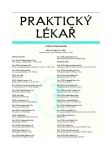Impaired function of muscles in the lower extremities in chronic obstructive pulmonary disease (COPD)
Authors:
M. Máček; J. Máčková; L. Smolíková; J. Radvanský
Authors‘ workplace:
Klinika rehabilitace a tělovýchovného lékařství 2. LF UK a FN Motol
; Přednosta: doc. PaedDr. Pavel Kolář
; Univerzita Karlova v Praze
Published in:
Prakt. Lék. 2009; 89(11): 634-638
Category:
Of different specialties
Overview
Muscle atrophy associated with impaired exercise tolerance is frequently observed in patients with chronic obstructive pulmonary disease and was considered as a benign complication without exploring the cause. Recently, the origin of this defect has been recognised and the possibility of limitation and reparation are found in complex pulmonary rehabilitation programs. In this way, the enzyme capacity of large extremity muscle groups can be increased and the limited oxygen uptake better utilized. Rehabilitation programs should be performed for at least 8 weeks in order to achieve a significantly increased quality of live.
Key words:
chronic obstructive pulmonary disease, physical activity, muscle dysfunction, rehabilitation programs.
Sources
1. Světová iniciativa o chronické obstrukční plicní nemoci. Praha; Vltavín, 2007.
2. Killian, K.J., Leblanc, P., Martin, D.H. Exercise capacity and ventilatory, circulatory, and symptom limitation in patiens with airflow limitation. Am. Rev. Respir. Dis. 1992, 146, p. 935-940.
3. Troosters, T., Casaburi, R., Gosseling, R. Pulmonary rehabilitation in chronic obstructive pulmonary disease. Am. J. Respir. Crit. Care Med. 2005, 172, p. 19-38.
4. Douced, M., Russell, A.P., Léger, B. et al. Muscle atrophy and hypertrophy signaling in patiens with chronic obstructive disease. Am. J. Respir. Crit. Care Med. 2007, 176. p. 261-269.
5. Agusti, A. Physical aktivity and chronic obstructive pulmonary disease. Am. J. Respi.r Crit. Care Med. 2008, 177, p. 675-677.
6. Debigaré, R., Marquis, K., Coté, C.H. et al. Catabolic/anabolic balance and muscle wasting in patients with COPD. Chest 2003, 124, p. 83-89.
7. Nader. G.A. Molecular determinants of skeletal muscle mass getting the „AKT“ together. Int. J. Biochem. Cell Biol, 2005, 37, p. 1985-1996.
8. Casaburi. R. Pulmonary rehabilitation for management of chronic obstructive pulmonary disease. N, Engl. J. Med. 2009, 360, p. 1329-1335.
9. Lacasse, Y., Goldstein, R., Lasserson, T.J. et al. Pulmonary rehabilitation for COPD. Cochran Database Syst. Rev. 2006, 4, CD003793.
10. Casaburi, R., Patessio, A., Ioli, S. et al. Reduction in exercise lactic acidosis and ventilation as a result of exercise training in patients with COPD. Am. Rev. Respir. 1991, 143, p. 9-18.
11. Maltais, F., LeBlanc, P., Sinard, C. et al. Skeletal muscle adaptation to endurance training in patients with COPD. Am. J. Respir. Crit. Care Med. 1996, 154, p. 442-447.
12. National Emphysema Treatment Trial Research Group. A randomised trial comparing lung-volume reduction surgery with medical therapy for severe emphysema. N. Engl. J. Med. 2003, 348, p. 2059-2073.
13. Fahy, B.F. Pulmonary rehabilitation for chronic obstructive pulmonary disease: a political and scientific agenda. Respir. Care 2004, 49, p 28-38.
14. Jones, P., Quirk, P.H., Baveystock, C.M., Littlejohns, P. A self-complete measure of health status for chronic airflow limitation. The St. George’s Respiratory Questionnaire. Am. Rev. Respir. Dis. 1992, 145(6), p. 1321-1327.
15. Committee of the Respiratory Structure and Function Assembly. Skeletal muscle dysfunction in chronic obstructive pulmonary disease. A statement of the American thoracic society and European respiratory society. Am. J. Respir. Crit. Care Med. 1999, 159, S2-S40.
16. Ringback, T., Brondum, E., Martinez, G. et al. Rehabilitation in COPD: the long-term effect of a supervised 7-week program succeded by a self-monitored walking program. Chron. Respir. Dis. 2008, 5, p. 75-80.
17. Gosselink, R.A., Wagenaar, R.C., Rijswijk, H. et al. Diaphragmatic breathing reduces efficiency of breathing in pacients with CPOD. Am, Respir. Crit. Care Med. 1995, 151, p. 1136-1142.
18. Breslin, E.H. The pattern of respiratory muscle recruitment during pursed lip breathing. Chest 1992, 101, p. 75-78.
19. Hernandez, P., Maltais, F., Gursahaney, A. et al. Proportional assist ventilation may improve execise performance in severe chronic pulmonary disease. J. Cardiopulm. Rehabil. 2001, 21, p. 135-142.
20. Berry, M.J., Rejevski, W.J., Adair, N.E. et al. Exercise rehabilitation and chronic pulmonary disease stage. Am. J. Respir. Crit. Care Med. 1999, 160. p. 1248-1253.
21. Lotters, F., Van Tol, B., Kwakekkel, G. et al. Effects of controled inspiratory muscle training in patiens with COPD: a metaanalysis. Eur. Respir. J. 2002, 20, p. 570-576.
22. Berry, M.J., Rejevski, W.J., Adair, N.E. et al. A randomised controlled trial comparing long-term and short-term exercise in patients with COPD. J. Cardiopulm. Rehab. 2003, 23, p. 60-68.
23. Troosters, T., Gosselink. R., Decramer, M. Exercise training in COPD; how to distinguish responders from nonresponders. J. Cardiopulm. Rehabil. 2001, 21, p. 10-17.
24. Smolíková, L., Máček, M. Fyzioterapie a pohybová léčba u chronických plicních onemocnění. Praha: Blue Wings, 2006.
Labels
General practitioner for children and adolescents General practitioner for adultsArticle was published in
General Practitioner

2009 Issue 11
Most read in this issue
- Nicotinism and the female skeleton
- Assessment of health state and working capacity of people suffering with locomotive system diseases
- Impaired function of muscles in the lower extremities in chronic obstructive pulmonary disease (COPD)
- Religion – evolution and neurobiology
